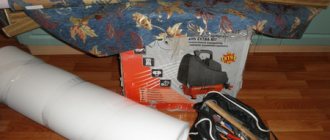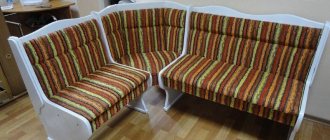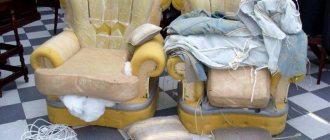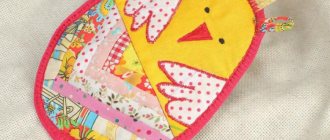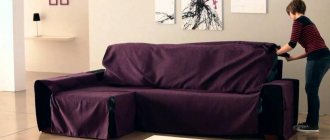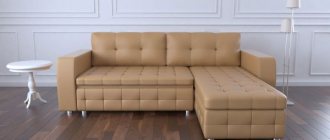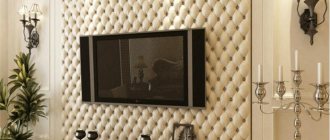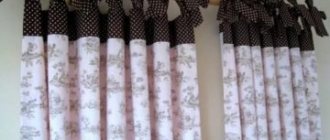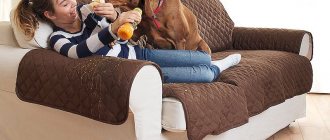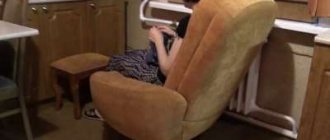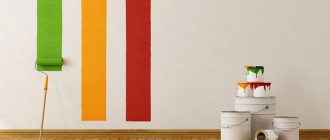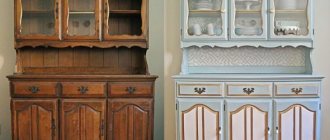Today, the kitchen in many apartments has become the most lived-in and favorite place: not only do the whole family have dinner here, but they often receive guests, conduct business conversations, and discuss the latest news with neighbors. That is why the kitchen corner, which decorates most kitchens, quickly loses its attractive appearance: the fabric on the seats wears out, becomes faded, and begins to tear. Structural elements become loose and unstable.
Although reupholstering furniture is considered a simple task, it is nevertheless important to have all the necessary tools at hand.
The kitchen corner, which decorates most kitchens, quickly loses its attractive appearance: the fabric on the seats wears out, becomes faded, and begins to tear.
Kitchen fumes also do their job, negatively affecting the strength of the material from which the seats and backs are made, as well as the condition of the filling. It gradually becomes saturated with moisture, falls off, loses softness and elasticity, which means the kitchen corner needs urgent help.
The kitchen corner, which decorates most kitchens, quickly loses its attractive appearance.
You can provide it by inviting a specialist who will carry out all the restoration and repair work. But it will bring great joy to the household if a home craftsman reupholsters the kitchen corner with his own hands.
Foam rubber is traditionally used as a filler when restoring kitchen corners.
Other tools may be needed to carry out restoration work, but their use will depend on their complexity.
What is furniture reupholstery?
Reupholstery is the replacement of upholstery and lining materials. Often, high-quality work results cannot be achieved without disassembling the furniture. The upholstery of many kitchen corners can only be updated by disassembling the structure into individual elements. It is easier to remove the old coating from them without causing damage to other parts. In most cases, repairing a kitchen corner is not limited to reupholstery, since you have to strengthen the frame of the sofa, cover it with varnish or paint, change fasteners, accessories, etc.
Removing old upholstery
To work, you will need an anti-stapler: a regular knife will help little in this case, and each stapler is equipped with a device for removing staples. The fasteners remaining in the wood are pulled out with pliers or pliers.
Remove the filler. Often the foam rubber ends up glued to the base. It is better to separate it from the back and seat with a knife. Sometimes foam rubber is attached with staples. In this case, you should use an anti-stapler. After removing the lining, remove the remaining foam and glue. The surface is cleaned.
Reupholstery and restoration of the kitchen corner
For many people, purchasing a new kitchen corner always takes a backseat, as it is expensive and there are always more important and necessary things to buy.
In one or two days it is quite possible to update a worn-out soft corner and refresh the kitchen interior.
In such a situation, restoration and reupholstery of the kitchen corner becomes a good option. Of course, you can take the furniture to a specialized workshop or call a craftsman directly to your home, but you can also do this work yourself.
A comfortable soft sofa in the dining area pleases the eye and gives the entire kitchen a feeling of coziness.
Such furniture has a fairly simple design, so restoration can be done even by a person with no experience, who has never wondered how to reupholster a kitchen corner.
Cut new upholstery and sew - if necessary
It will not be possible to reupholster a kitchen corner with high quality without first cutting out the upholstery material. It's easier to make a pattern if you still have the old upholstery. It is necessary to take into account that during re-upholstering the material will have to be bent and tucked. When planning to replace a thin filler with a thicker one, you need to increase the size of the pattern.
Stitching may be required if the upholstery is in pieces. Sometimes it is a covered polyurethane foam mattress. It is better to cover thick filling with sewn material. In most cases, there is no need to sew it along the edges. It will be enough to secure the fabric with furniture nails or staples.
How to tighten it with your own hands?
To restore a kitchen corner yourself at home, you need to understand the sequence of actions of this process. It is worth considering the main stages of remodeling old furniture and its complete transformation.
- Removing old upholstery from a kitchen corner using a staple remover or a tool you have at home for removing furniture staples. It is better not to throw away the material; it will be useful for cutting new upholstery.
- Remove the old layer of foam rubber so that there are no residues. If the foam rubber was glued, then it will be possible to remove it completely only with the help of a knife.
- Cut out new upholstery using old samples. The new pattern must exactly match the one that was previously eliminated, otherwise replacing one with another will be problematic. It is best to mark the edges of a new product using chalk or a bar of soap so that the incorrectly made part can be easily erased. When cutting out a pattern, it is important to leave 5 cm on each side to make starts that will tuck during attachment to the furniture frame. It is recommended to buy material with a reserve so that there is enough of it during cutting. If there is anything left after creating the patterns, you can use the fabric for its intended purpose and update chairs or stools, and, if desired, make soft cushions for the future kitchen corner.
- The finished templates are sewn together using a sewing machine. It is worth making several seams to maximize the strength of the structure and prevent it from coming apart in the future.
- Repairing a kitchen corner also involves replacing the soft component, so it is necessary to lay new foam rubber and secure it. For fixation, you can use various glues: construction glue, from a gun or “Moment”. If there is no desire or need to attach the soft component to the frame, you can connect it to the upholstery, securing it with furniture nails or staples.
- The final touch will be putting new covers on the kitchen corner and checking their size. If something needs to be redone, there is still an opportunity for this. As soon as everything is in place, the most important stage begins, in which you should not rush - this is attaching new upholstery to old furniture. You can work using an industrial stapler, which quickly and securely fixes staples to the base of furniture. The staples should be spaced quite often, at least 4 cm between each of them, otherwise the material will begin to turn out, which will spoil the impression of the work performed.
- If you managed to sheathe all the parts of the kitchen corner frame, then you can put all the parts together, put the furniture away and try to use it.
Working step by step, you can achieve the desired result and update old furniture in the kitchen, completely transforming it, and, if desired, radically changing it.
If you carry out the work correctly and follow the advice, you can replace damaged and worn upholstery in the kitchen within one day, enjoying the results for many years.
Frame repair – if necessary
The frame of the kitchen corner must be carefully inspected and elements that have become unusable must be replaced. Accurate markings and accuracy in processing parts will help avoid mistakes in assembling furniture.
If the coating has peeled off the legs, they need to be cleaned of dust and dirt. Then the wood is sanded. Delaminations, gaps and cracks are filled with wood glue.
High reliability of gluing is ensured by clamps that press the contacting surfaces together. After priming, varnish or paint can be applied to the wood. Holes for fastening in the updated frame elements are drilled before gluing the filler.
Choosing the right material
Any material can be used to reupholster a kitchen corner. Restoration is especially useful for those who want to change the interior, add modern notes, and show imagination. Textile is the most popular upholstery material. You can choose the most suitable fabric in terms of color and characteristics. The most common include:
- Tapestry. Durable, attractive fabric. The advantages include long service life and a wide palette of colors.
- Velours. Very durable fabric. The downside is that over time the pile gets rubbed off, so it loses its presentable appearance.
- Flock. High-quality upholstery material, very durable, abrasion-resistant. Moisture-resistant impregnation will make it possible to easily wash and remove stains that often appear on furniture in the kitchen.
- Jacquard. A beautiful fabric, often used for furniture, but wears out quickly. Getting rid of dirty marks on it is quite problematic.
Tapestry
Jacquard
Flock
Velor
Often, to renovate a kitchen corner, people choose artificial leather. Externally, as well as in properties, it is not inferior to natural, the cost is much less. The disadvantages include the fact that leatherette does not “breathe”. In addition, thin material will soon wear out, crack or tear, so it is necessary to select it correctly. It is optimal to use the following fabrics:
- PU leather. It is durable, resistant to damage, and heat resistant. This is possible thanks to the three-layer structure. The first is cotton, which gives softness and comfort. The second layer is genuine leather with some defects. The third is polyurethane, which gives the material the selected color and texture.
- MF leather. Not cheap, it can be difficult to distinguish it from natural one. Resistant to damage, odorless, highly water resistant. Thanks to this, stains from the surface are easily removed.
- Eco leather. The material is made from safe and environmentally friendly polyurethane. It will not provoke an allergic reaction. The main advantages include elasticity and odorlessness.
- PVC leather. Quite often used in the manufacture of furniture. Has a more affordable price. Its performance characteristics are also excellent: strength, elasticity, ease of maintenance. The disadvantage is that polyvinyl chloride, if the production technology is disrupted, releases substances hazardous to health.
Types of corner kitchen cabinets, rules for choosing them
Genuine leather is the most expensive material. Fits perfectly into the kitchen interior and emphasizes the taste, style, and social status of the homeowners. In addition, she needs extremely careful treatment:
- should be located away from heat sources;
- needs delicate care with special detergents. It is also important to prevent mechanical damage, otherwise a complete replacement of the furniture may be necessary.
To cover furniture, you need to calculate the required amount of material. You should remove the old upholstery from the corner and measure the protruding parts. After this, you need to add up the resulting vertical dimensions and add about 20% for allowances. The required width of the material is determined by the widest part of the old upholstery.
In standard furniture options, foam rubber is usually used as a filler; it is cheap, but very quickly loses its elasticity. Sintepon has the same characteristics. A more expensive, but high-quality option is polyurethane foam. It will last several times longer than other fillers. To make the design of the kitchen corner brighter, you can use different materials and even contrasting colors for the back and seat, for example, black and white, yellow and blue. The choice is unlimited - even light-colored furniture can be practical if the right, easy-to-care fabrics are chosen.
PU leather
PVC leather
Genuine Leather
Eco leather
MF leather
Fabric and other materials for updating the kitchen corner
When choosing a material for the restoration of a soft kitchen corner, focus on wear resistance and quality. Giving preference to beautiful colors without paying attention to the strength of the fabric is not the best solution.
To avoid having to update the corner every year, carefully study the range of furniture fabrics and choose the most optimal strength-beauty ratio. The stores will offer you many options; consider the most popular types of furniture fabric.
Tapestry
A material with good density and wear resistance, so it is the most popular option for furniture upholstery; products in the tapestry will remain beautiful for a long time, and the availability of a variety of colors and designs will allow you to choose upholstery for any kitchen.
Velours
The material has good strength indicators, so it will also serve for quite a long time; the structure of velor has a small and dense pile, thanks to which the furniture looks stylish and very beautiful, and is very pleasant to the touch and use; The disadvantages include the abrasion of hairs and the gradual deterioration of the appearance of the upholstery.
Flock
High-quality and dense material that is well suited for upholstering a kitchen corner due to its wear resistance and water-resistant impregnation; it makes it easy to remove any debris and stains from the surface of the furniture.
Jacquard
A material that looks beautiful and stylish, but is least suitable for the kitchen, as it wears out quickly and is difficult to clean from stains.
Furniture fabric looks beautiful, is inexpensive and easy to use , in addition, it will not be difficult to work with it when changing the upholstery. If you want to do something more extravagant and expensive, then covering it with leatherette would be a good option. Various materials can be used.
Gozhka
The fabric, like jacquard, is well suited for upholstering sofas in the kitchen, provided there are no pets. The weave is reminiscent of burlap, but the texture is a little softer.
The material is dense, does not wrinkle and holds its shape well. It is tear resistant. The matting has a natural base, but to improve performance characteristics, polyester or acrylic threads can be added to the weaving.
Dirt from the matting is easily removed. Simply wipe the fabric with warm soapy water or water-based products. Bleaching compounds cannot be used to clean a matting-covered corner.
Chenille
The material is pleasant to the touch and affordable in price. A big advantage of chenille is its increased tear resistance. The material does not absorb odors and does not fade for a long time.
In addition to furniture fabric, leather and various modifications of this material are often chosen for the kitchen corner. Leather upholstery is easier to care for, looks rich and extravagant, and lasts a long time. Let's consider the options from which you can choose upholstery for the kitchen corner.
Addition. To decorate a corner upholstered in leather, use the carriage screed technique. Spectacular and rich furniture with similar decor symbolizes refined taste and wealth.
Genuine Leather
The most expensive and whimsical option. Without special skills, it is not recommended to work with this complex material; natural materials have their own characteristics. You should take on such work only if you are completely confident in your skills.
Skin requires special care and respect. She needs specialized cleaning products and should be protected from sharp objects and pets. But with proper care, genuine leather is very durable and does not lose its rich appearance for many years.
PU leather
Artificial material based on polyurethane. In terms of strength and abrasion resistance, it is slightly inferior to natural leather.
Soft, elastic and beautiful artificial leather of this variety will decorate furniture and will serve for a long time.
MF leather
If you decipher the letters in the name, this variety will immediately become well recognizable. Microfiber is made from the finest polyester fibers. This is a more expensive and functional material, it is closer to its natural counterpart.
Microfiber is moisture resistant, does not lend itself to abrasion for a long time and does not require complex care. Breathable microfibers make this upholstery especially comfortable. An excellent choice for kitchen furniture.
Eco leather
Two-layer artificial material. Fabric is used as a base, and the top layer consists of colored polyurethane. High-quality polymers that are used in the production of this type of artificial leather make it a hypoallergenic and safe material. Eco-leather is soft and pleasant to the touch, imitates natural leather well and is resistant to abrasion.
PVC leather
This material is made from polyvinyl chloride. The top layer is a one-sided monolithic or porous PVC applied to a fiber base. PVC leather is most often found in everyday life, since it is the most inexpensive and accessible artificial material. It is elastic, durable and easy to care for.
Its wear resistance characteristics are quite good, but there is one drawback - harmful substances. PVC production is not environmentally friendly; this factor can be decisive when choosing upholstery for kitchen furniture.
Peculiarities
Kitchen furniture must have certain qualities in order to serve for many years and remain comfortable and attractive in appearance. The frame is usually made of MDF or chipboard, less often of wood, since it is much more expensive, but each of the materials, when used correctly, can last for quite a long time, without losing its attractiveness, which cannot be said about the upholstery. Manufacturers choose different materials for the upper part of the kitchen corner, but each of them sooner or later begins to deteriorate, which leads to the need to completely change the furniture. If the furniture in the kitchen is of high quality and comfortable, and also completely satisfies the owners, there is no point in buying new ones; it is best to replace worn-out parts and cover the corner with new material.
Restoring old furniture will be much cheaper than buying a new set, and in this case there are much more opportunities for independently selecting materials and internal filling.
In order to update old furniture, it is necessary to study exactly how the upholstery is changed and the kitchen corner is restored. Having certain skills and abilities in this area will be useful, but even without them you can achieve your goal. The main task will be the correct selection of materials for the upholstery and the filling underneath, so that the material is easy to clean , which is important for the kitchen, can withstand increased loads and fits the design of the room. To ensure a positive result of the alteration, you must also have all the tools that will allow you to successfully cut out the new upholstery, remove the old one, and replace the old one with the new one.
Required Tools
It is only possible to reupholster a kitchen corner with your own hands in a high-quality manner only in a situation where you have all the required tools. The master will need:
- an anti-stapler, an ordinary knife or a flat screwdriver to remove the staples when removing the previous upholstery;
- hammer;
- knife for cutting material;
- open-end wrenches, which are needed to disassemble the furniture frame;
- sewing machine;
- furniture cardboard, which is used to make even stitches and seals;
- a stapler used to attach new upholstery;
- accessories;
- foam glue.
Before updating an old kitchen corner, you need to prepare fabric and foam rubber. It’s also worth finding a simple master class, especially if you don’t have similar work experience.
Furniture cardboard
Hammer
Metal knife
Foam glue
Open-end wrenches
Stapler
Accessories
Sewing machine
Anti-stapler
Stages of work
When reupholstering furniture, there are several stages that will be necessary in all cases with rare exceptions. Let's take a closer look at how to cover a kitchen corner with your own hands.
Removing the upholstery
To remove the upholstery, we need to gain access to the parts we need. If the back of the kitchen corner is covered with a fiberboard sheet, carefully remove it. Using an anti-stapler, remove the furniture staples that secure the old upholstery and remove it as carefully as possible, since we will need it later.
Use an anti-stapler to remove old upholstery.
The filler in kitchen corners is usually glued to the frame. Therefore, tearing it off the glue will not be difficult. If somewhere after this there are remains of filler on the plywood of the frame, remove them with a knife.
Calculation of filler amount
Foam rubber is most often used as a filler. This material is relatively cheap and convenient, but it absorbs unpleasant odors. Therefore, when reupholstering kitchen furniture with your own hands, it is necessary to replace it. The amount of filler is calculated in the same way as fabric - measuring old foam rubber. The thickness is selected taking into account the type of furniture.
Cutting fabric and filling
First you need to prepare patterns for new upholstery on thick paper. This is where the old upholstery comes in handy. It needs to be straightened with your hands, and in case of a strong jam, ironed. After that, lay it out on paper and trace around the perimeter with a pencil, including all overlaps.
Choose high-quality foam rubber.
After this, cut out templates from paper, according to which you can begin cutting out the prepared material.
The foam rubber for the filler is cut out exactly according to the same principle.
Important! To keep the shape as long as possible, when cutting out the filling, add 1 cm from each edge.
Frame repair
Carefully inspect the frame of your kitchen nook with the upholstery removed. Clean the elements from dirt if necessary. Minor cracks can be filled with glue. If there are severely damaged elements, then you need to carefully unscrew them.
To disassemble the angle frame, open-end wrenches can be useful.
Measure the removed parts and cut new parts from the prepared plywood using the resulting dimensions. Drill holes for mounting in the required places. Assemble the frame with new parts.
Reupholstery and assembly
Glue is applied to the plywood base of the kitchen corner, onto which foam rubber is placed. Next, you need to cover the corner parts with material and use furniture staples and a stapler to secure the fabric.
Be careful when re-tightening the soft corner.
Work with the material slowly and carefully to avoid tears and distortions of the upholstery. If the kitchen corner consists of blocks, then first assemble the corner part, and then the side parts. Complete the kitchen nook assembly by attaching the fiberboard back wall.
Manufacturing process: step-by-step instructions
There are no minor parts in the manufacturing process
Every nuance is important, and therefore it is extremely important to follow the instructions and recommendations
If you are planning a long sofa, first cut out the necessary parts:
- bottom, plywood is suitable for making this part;
- bars for the frame part;
- sidewalls made of chipboard, 2 pieces required;
- side parts for the long sides of the box - you also need two parts, which can be made from plywood;
- back;
- sitting
It is very important to take clear measurements so that there are no problems when connecting the structure.
The next stage is assembly. You need to assemble the sofa in a certain order:
- The edges cover the ends of the sidewalls, and the bottom is covered with thrust bearings.
- Using a screwdriver and self-tapping screws, the frame is assembled, and then the box.
- The back is assembled and attached to the sides using dowels. You can strengthen the fastening using metal corners.
If it was planned to make a short sofa, then all actions will be similar. Only the size of the parts changes.
The most economical option is to use particle board or oriented strand board.
After the long and short sofas are ready, they are combined into one structure using a connecting element. Metal corners with the help of dowels attach the seat to the back, and then attach it to the side. The last stage is upholstery, if it is planned, of course.
If upholstery is not planned, then the wood can be treated with primer and varnish. To change the color, you can use tinting or paint.
How to decorate
The updated kitchen corner can be left unchanged or decorated. Several popular decoration options:
- decoupage;
- pillows with contrasting covers;
- adding bright accents in the form of rollers or blankets;
- decoration with inserts made of genuine leather or suede;
- use of knitted capes;
- hand painted;
- fastening plywood ornaments.
For decoration, stencils are used that will help you apply designs of varying degrees of complexity onto wooden panels. The use of fringe or tassels is no longer relevant. A repeating pattern is applied to the arms, legs and small plain elements.
You should not use more than two ways to decorate a kitchen set. Too much decoration will ruin the appearance of the corner. It is better to opt for a more concise option.
The decoupage technique should be used with caution. For decoration, one color scheme and one type of pattern are used. If the kitchen already has furniture or appliances decorated in the same way, then it is better to abandon this idea. Otherwise, the appearance will be rustic and rustic.
Even a novice craftsman can reupholster a kitchen corner. The main thing is to strictly follow the step-by-step instructions, do the work carefully and without haste. Updated furniture will decorate the kitchen.
Where to put the sofa
When choosing a sofa model, it is important that after its installation there is enough space for free movement. Ideally, it should not occupy more than 20% of the total space. It is better to install a corner sofa in a kitchen that is at least 14 square meters. meters. Otherwise, you should limit yourself to a small straight sofa or completely abandon this idea.
You can install the sofa:
- Along the wall. Installation opposite the kitchen unit is a classic location for a standard kitchen.
- Along one wall with a set, it is practical to place a sofa in a long and narrow room.
- Near the window. They install small structures or a bay window sofa.
Making a sofa for the kitchen is not difficult, you just need to follow the instructions, or watch the video for clarity. You should not be afraid of difficulties - the creative process will bring pleasure, and the result will delight you with a comfortably equipped area.
How to sew a cover yourself
To protect the upholstery, you can use a corner cover. First you need to choose the shape of the cover and fabric. Draw it yourself or find the appropriate pattern on the Internet. Take some old fabric, cut it according to the patterns and sew it.
You can use leather or fabric upholstery on the sofa.
Try the resulting draft on your corner. If any defects are found, correct them. If you are satisfied with how the trial version fits on the corner, then proceed to cutting out the main material. Sew in zippers and clasps if necessary. Decorate the case as you wish.
Choose the color of the fabric based on the interior design of the kitchen.
Place the finished cover on your kitchen corner. But don’t get carried away with decorating too much, because this is a cover designed for a kitchen corner, and an abundance of decorative elements will look inappropriate there.
The leather upholstered corner is easy to use and care for.
Desk for two children: choosing the ideal option
But in most kitchens this is an extra element that simply won’t fit due to its size. It is much more logical and practical to make a corner compact design. A sofa bench works great here. This is a bench, often corner, with a convenient design, under which there are additionally hidden niches for various small items and kitchen utensils. They are the ones most often found on sale, and you can assemble them yourself. Finding assembly diagrams is not a problem at all these days. The main thing here is to take into account some nuances.
I’ll say right away that if you have a small kitchen, it’s better to transfer ideas and drawings with a folding design to the bedroom or living room.
In the kitchen you need a small sofa that will provide comfortable seating. It is not focused on constant sleep.
A kitchen sofa is usually angular or straight. A lot here depends on the shape and size of the kitchen itself, and how the furniture will be arranged.
There are a few key features to keep in mind before you start assembling it yourself.
- Height. Kitchen sofas are made higher than ordinary sofas for living rooms and bedrooms. If you've sat at a table on a regular sofa, you'll immediately understand what I'm talking about. Convenience will be questionable;
- Material of manufacture. We will talk about this separately later. But kitchen sofas are made only from practical materials that are easy to clean;
- Dimensions. They should be compact. Kitchens in the vast majority of cases are small and do not have a huge amount of space.
Now we will separately consider some issues related to self-assembly.
